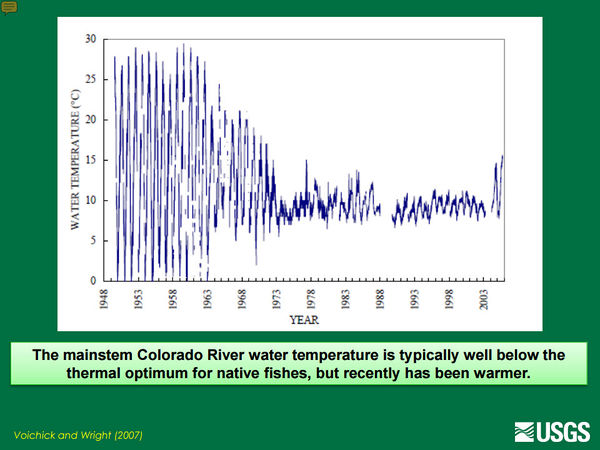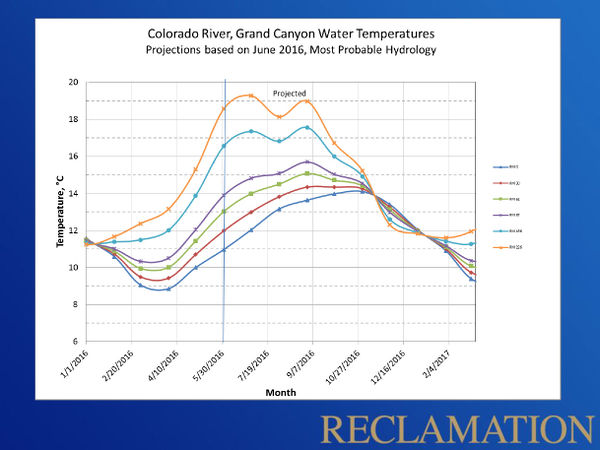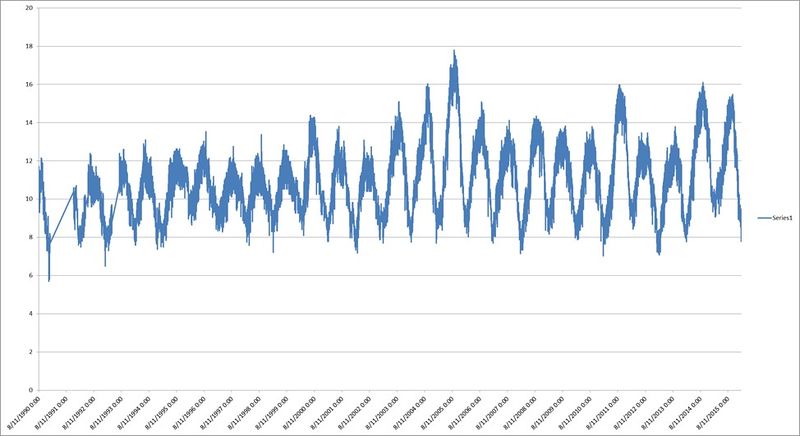Difference between revisions of "TEMPERATURE"
Cellsworth (Talk | contribs) |
Cellsworth (Talk | contribs) |
||
| Line 54: | Line 54: | ||
| − | [[File:Temperature bl LCR 1990 2015.jpg|center|800px | + | [[File:Temperature bl LCR 1990 2015.jpg|thumb|center|800px|Water Temperatures at the Little Colorado River Confluence (RM 61), 1990-2015]]<br> |
| − | + | ||
[[File:ForebayTemp 2000 2016.jpg|thumb|center|500px|Forebay temperature 2000-2016]] [https://www.usbr.gov/uc/rm/amp/twg/mtgs/17jan26/AR4_Radtke.pdf] | [[File:ForebayTemp 2000 2016.jpg|thumb|center|500px|Forebay temperature 2000-2016]] [https://www.usbr.gov/uc/rm/amp/twg/mtgs/17jan26/AR4_Radtke.pdf] | ||
| Line 104: | Line 104: | ||
'''2017''' | '''2017''' | ||
*[https://www.usbr.gov/uc/rm/amp/twg/mtgs/17jan26/AR4_Radtke.pdf Water Quality in Lake Powell and Its Influence on the Colorado River Below Glen Canyon Dam PPT] | *[https://www.usbr.gov/uc/rm/amp/twg/mtgs/17jan26/AR4_Radtke.pdf Water Quality in Lake Powell and Its Influence on the Colorado River Below Glen Canyon Dam PPT] | ||
| − | *[https://digitalcommons.usu.edu/cgi/viewcontent.cgi?article=1951&context=wats_facpub Pine et al. Growth of Endangered Humpback Chub in Relation to Temperature and Discharge in the Lower Colorado River. USU Watershed Sciences Faculty Publications] | + | *[https://digitalcommons.usu.edu/cgi/viewcontent.cgi?article=1951&context=wats_facpub Pine et al. 2017. Growth of Endangered Humpback Chub in Relation to Temperature and Discharge in the Lower Colorado River. USU Watershed Sciences Faculty Publications] |
| − | *[[Media: | + | |
| + | '''2015''' | ||
| + | *[[Media:2012 LTEMP-DOI Meet-Temp-Valdez (1).pdf| Benefits and Risks of Temperature Modification at Glen Canyon Dam to Fishes of the Colorado River through the Grand Canyon]] | ||
'''2013''' | '''2013''' | ||
| Line 114: | Line 116: | ||
'''2012''' | '''2012''' | ||
| + | *[[Media:2012 LTEMP-DOI Meet-Temp-Valdez.pdf| Temperature Considerations in the RTCD alternative for LTEMP]] | ||
*[https://www.gcmrc.gov/about/ka/KA%202%20-%2010-19-11/AM%20Talks/Grams%20Flow%20Temp%20Turbidity.pdf Flow Temp Turbidity ] | *[https://www.gcmrc.gov/about/ka/KA%202%20-%2010-19-11/AM%20Talks/Grams%20Flow%20Temp%20Turbidity.pdf Flow Temp Turbidity ] | ||
*[https://www.gcmrc.gov/about/ka/KA%202%20-%2010-19-11/PM%20Talks/Ward%20-%20Effects%20of%20temperature%20on%20native%20fish.pdf Effects of Temperature on Native Fish ] | *[https://www.gcmrc.gov/about/ka/KA%202%20-%2010-19-11/PM%20Talks/Ward%20-%20Effects%20of%20temperature%20on%20native%20fish.pdf Effects of Temperature on Native Fish ] | ||
Revision as of 11:54, 25 September 2018
|
|
Water Temperature below Glen Canyon DamPrior to completion of Glen Canyon Dam in 1963, the temperature of water flowing through the Grand Canyon each year was highly variable, ranging from the icy, spring run-off to the warm, 85-degree summer-heated flows. However, once the dam was constructed, the temperature of the water released from the dam - drawn from the depths of Lake Powell and released through the dam's penstock intakes - ranged for many years between 45 and 50 F (7 to 10 C). With the lowering of Lake Powell, release temperatures have been increased to as high as 59 F (15 C) which has likely led to an increase in the humpback chub and other native fish populations in Grand Canyon. These increases in temperature, however, also increase the risk of expanding the distribution and abundance of cool/warm-water nonnative fish like brown trout, green sunfish, smallmouth bass, and walleye which could have a devastating impact on the humpback chub population in Grand Canyon like they have on humpback chub and other native fish populations in the Upper Basin. |
| --- |
--- |
--- |
|---|



